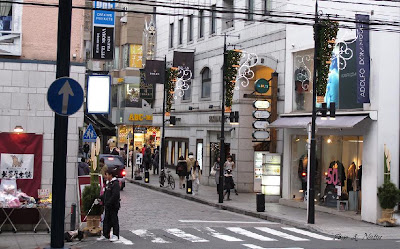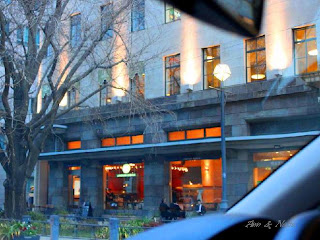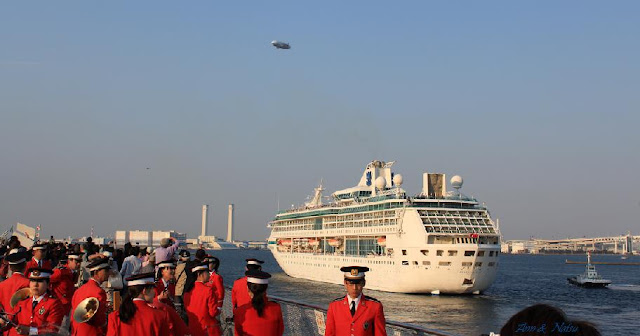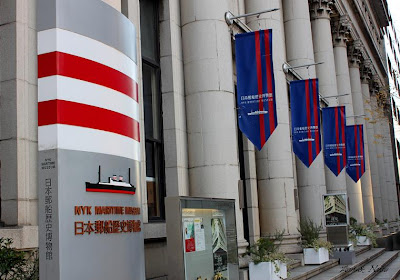(Please click photos to look at large.)
These are my favorite street corners in Yokohama
These are my favorite street corners in Yokohama
which change with the passing of the seasons.
My husband is all for window-shopping
around Kannai 関内 or shopping street Motomachi 元町
SHINANOYA
The clothing store was established in 1866.
 Motomachi shopping street 橋を渡り元町へ
Motomachi shopping street 橋を渡り元町へ
門松が飾られているので、お正月の初売り日だと思います。

while out for a walk on the weekend.
The clothing store was established in 1866.
素朴な美味しさの食パンが好きです。
震災後のパン不足の際でも購入できて嬉しかった。
震災後のパン不足の際でも購入できて嬉しかった。
 Motomachi shopping street 橋を渡り元町へ
Motomachi shopping street 橋を渡り元町へ門松が飾られているので、お正月の初売り日だと思います。

In contrast, I'm fond of shooting impressive scenes.
It is rare, but not unheard of. (LOL)
It is rare, but not unheard of. (LOL)

 Ōsanbashi Pier 大桟橋
Ōsanbashi Pier 大桟橋The Former Foreign Settlement is also located in this Kannai area.
Until 1899 foreigners in Yokohama were forced to live apart from Japanese
in an area called (still today) Kannai, which means "inside the barrier."
Kannai / 関内
There were commercial pursuits photos called Yokohama photos
横浜写真
which were hand-painted on monochrome.
These were made for foreigners as a souvenir
横浜写真
which were hand-painted on monochrome.
These were made for foreigners as a souvenir
in the Meiji/Taihso era.
It's fun to seek a sense of the Yokohama of long ago.
It's the 152th anniversary of the opening of the port on Jun 2nd 2011.
It's the 152th anniversary of the opening of the port on Jun 2nd 2011.
Yokohama Harbour
The Japanese only started eating beef after the Meiji Restoration.
Sukiyaki was one of the first dishes to use beef, and it has been popular since then.
Thinly-sliced beef, vegetables, tofu, and some noodles made of konnyaku are cooked in a shallow iron pan and seasoned with sugar, sake, and soy sauce. Most Japanese like to dip sukiyaki in raw egg, though many foreigners are reluctant to. In the 1860s when Japan was opened to foreigners, new cooking styles were also introduced. Cows, milk, meat, and eggs became widely used, and sukiyaki was the most popular way to serve them. The first sukiyaki restaurant, Isekuma, opened in Yokohama in 1862.
日本人が牛肉を食べるようになったのは、明治維新以後のことです。
「すき」には農具の鋤の、「やき」には「焼く」の意味がありますから、もともとは鋤で肉を焼いていたのではないかという人もいます。
出来上がったものを溶き卵に浸して食べるのが日本人の好みですが、これには抵抗を感じる外国人もいます。
「すき」には農具の鋤の、「やき」には「焼く」の意味がありますから、もともとは鋤で肉を焼いていたのではないかという人もいます。
出来上がったものを溶き卵に浸して食べるのが日本人の好みですが、これには抵抗を感じる外国人もいます。
安政6年(1859年)の横浜が 開港後、居留地の外国人たちから食肉文化も入ってきた。
日本に肉牛畜産の産業がなかったが、幕府は(1864年)居留地に指定されていた海岸通に屠牛場の開設を認めている。
1862年、横浜入船町で居酒屋を営んでいた伊勢熊(いせくま)が店を二つに割って牛鍋屋を開業する。
一般にこれが最初の牛鍋屋だと言われている。
明治元年(1868年)、高橋音吉が「太田なわのれん」を操業し、味噌煮込み風牛鍋の原型を作った。1862年、横浜入船町で居酒屋を営んでいた伊勢熊(いせくま)が店を二つに割って牛鍋屋を開業する。
一般にこれが最初の牛鍋屋だと言われている。
横浜ではぶつ切り牛肉を使い、適宜、割下を注ぎながら濃い味噌だれで炒りつけるように煮る牛鍋を供する店がある。
幕末期、開港場の横浜では牛肉の煮売り屋台があった。ぼたん鍋の転用で、味噌煮込みであったらしい。
明治初期の「牛屋(ぎゅうや)」の牛鍋もこうした味噌鍋が主流であったと思われる。




















Wow ! I love the antique photos, So precious !!!!!
返信削除Thanks for sharing
xoxo
A truly fabulous series!! I especially love the contrast here- seasons and past (the old city). I enjoyed the architecture and the pier. Nice presentation:)
返信削除すきやきのすきが、鋤なんて知りませんでした。
返信削除牛肉を食べる歴史ってまだ浅いですよね。
最近は、価格も高かったりするのであまり食べてませんが、
たまによいものを食べるとやはり美味しいと感じます。
牛鍋、、たまらなくおいしそうです。今度帰国したらぜひ行きたいです。
返信削除Dear Anzu, how pleasant to visit japan with the help of your nice blog! thank you.
返信削除I smell the yummy Sukiyaki! I'm hungry now. I have been to Yokoham only once while lived in Tokyo for seven years. Really stylish place! It is interesting in the photo of Pier of Yokohama, almost all people are in western style clothes. 横浜開港記念館、素敵ですね!
返信削除All your photos are impressive, Anzuさん! Yokohama kind of reminds me of Kobe, which I guess is similar because they are both ports. Anzuさんの写真を見るだけで魅力いっぱいの横浜を散歩できた気分になりましたヾ(●´∀`)ノありがとうございます♪
返信削除I'm glad of hearing you enjoy a momentary sense of a trip around harbour.
返信削除是非、横浜へ遊びに来て下さいね。
I'm not a giant fan of sukiyaki in raw egg, but my husband's family often ate it that way. We've never been to Yokohama. Isn't that where Sakamoto, Ryoma was? We just got done watching the Ryoma series and loved it. Yokohama sounds like a wonderful place and your photos are terrific.
返信削除うわ、おいしそうですね!
返信削除私はすき焼きが大好きです。
しゃぶしゃぶも好きです。
日本料理は最高です。^^
It really looks like a nice neighbourhood and I simply love the vintage photos.
返信削除Yokohama has a good vibe. I like it better than Tokyo in some ways.
返信削除Such lovely pictures!
返信削除I really must visit Yokohama sometime soon, it seems so pretty and so *open*. Especially compared with Tokyo.
And sukiyaki... I LOVE IT! <3
>煙突のある美しい街並み。
返信削除そうなんですね。
しかし、今の家は煙突がほとんどありませんね。
みんなもっと環境に優しいヒーターを使っていますから。